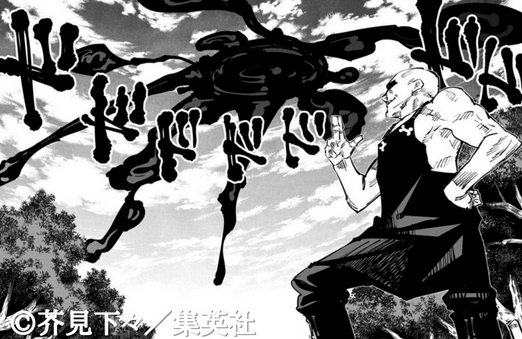
This section introduces the Contractual Curse Technique (Shokutakushiki) from “Jujutsu Kaisen.” This technique involves the use of a scroll as a barrier, which can be endowed with special powers by a sorcerer. Additionally, a sorcerer can delegate their scroll to someone else, a method known as the Contractual Curse Technique. This article will delve into the nature of this ability, its mechanics, and the reasons why Suguru Geto utilized it in “Jujutsu Kaisen.”
The Scroll in “Jujutsu Kaisen”
The Contractual Curse Technique used by Suguru Geto involves delegating one’s scroll to a substitute, using an object called “Moto” for the process. The strength and efficiency of a scroll vary according to the sorcerer’s abilities. However, if the sorcerer is defeated, the scroll is also nullified. The Contractual Curse Technique not only circumvents the risks associated with traditional scrolls but also allows for strengthening the barrier depending on where the stakes are placed. The following is a detailed exploration of the abilities of the Contractual Curse Technique and why Suguru Geto employed it in “Jujutsu Kaisen.”
“Jujutsu Kaisen” Series Information
呪術廻戦 コミックス23巻
— 呪術廻戦情報@HAGANEDUKA SHOP (@jujutsu_jouhou) June 5, 2023
表紙が公開されました!
九十九由基!
⬇️Amazonhttps://t.co/at9i9uKnBW
⬇️楽天ブックスhttps://t.co/Iz3bMlTzxl#呪術廻戦 #呪術本誌 #JujutsuKaisen pic.twitter.com/WseegF1n5K
“Jujutsu Kaisen” has gained popularity with its unique world centered around curses. Created by Gege Akutami, this dark fantasy series has been serialized in “Weekly Shonen Jump” as of November 2023.
Overview of “Jujutsu Kaisen”
As of October 2023, 24 volumes of “Jujutsu Kaisen” have been published. By July of the same year, the series surpassed 80 million copies in cumulative domestic circulation. The anime series began in October 2020, and a movie adaptation was released in December 2021.
Synopsis of “Jujutsu Kaisen”
Set in Sendai City, high school student Yuji Itadori lives with his grandfather. On the night of his grandfather’s death, cursed spirits and monsters start to appear due to school curses. Amidst the chaos, Itadori strives to rescue a stranded senior. Cornered, he consumes “Sukuna’s Finger,” gaining immense power but becoming Sukuna’s vessel in the process. Facing a death sentence from the sorcerers, Itadori enrolls in the Tokyo Metropolitan Jujutsu Technical High School to train as a sorcerer.
What is a Barrier in “Jujutsu Kaisen”?
In “Jujutsu Kaisen,” a barrier is a conjured domain used by sorcerers to camouflage their activities. Even those without innate sorcery skills can cast a basic barrier. The purpose of casting a barrier is to prevent intrusion by outsiders and to avoid creating new Cursed Spirits. If a sorcerer’s mission is witnessed by ordinary people, their fear could give rise to new curses. Thus, barriers also serve to prevent such vicious cycles.
Barriers are activated by uttering specific words and manifesting a black liquid, forming a protective shield. The strength of the barrier increases with the risk associated with the sorcerer stepping outside of it. However, barriers are primarily used to prevent external intrusion, with sorcerers often remaining inside them. If a sorcerer is defeated, the barrier is also dispelled, so it’s common to have an assistant director cast the barrier during missions.
This use of barriers to prevent external intrusion is typical in “Jujutsu Kaisen.” Powerful sorcerers can even imbue barriers with special powers. For instance, they can set conditions on who or what can enter or leave the barrier, or designate it to a specific individual. However, such advanced techniques require considerable skill to execute.
What is a Commissioned Barrier in “Jujutsu Kaisen”?
In “Jujutsu Kaisen,” barriers function like magical domains. Although the strength of a barrier increases with the sorcerer’s ability, a major drawback is that if the caster is defeated, the barrier dissipates. No matter how strong the barrier, if the person who cast it is taken down, it becomes ineffective. To address this, the concept of a commissioned barrier was developed.
What is a Commissioned Barrier?
During a mission, if a sorcerer casts their own barrier, there’s a risk of it being dispelled if they are defeated. Even if someone else is arranged to cast the barrier, it’s not guaranteed to stay intact under all conditions. Even a barrier of considerable strength becomes pointless if the opposing force is overwhelming. Hence, the ability to have another individual cast one’s own barrier was conceived as a commissioned barrier.
A commissioned barrier allows a sorcerer to delegate the task of casting their barrier to another party. This is done using a “base,” a stake infused with the sorcerer’s energy and incantations. Once this base is in place, the delegate can then cast the barrier. Crucially, even if the sorcerer or the delegate is defeated, the barrier does not dissolve. The only way to break the barrier is to destroy its base.
The Mechanics and Effects of the Commissioned Barrier
A commissioned barrier, as the name suggests, is a delegated execution of one’s barrier. To activate it, a “base” or stake, charged with the sorcerer’s cursed energy and incantations, is used. Even if the sorcerer or the delegate is defeated, the barrier does not dissipate. The barrier, created by the “base,” remains intact until the stake itself is destroyed. Therefore, if the sorcerer is incapacitated, the risk of the barrier disappearing is avoided.
Commissioned barriers prove to be effective, especially in missions where the integrity of the barrier must not be compromised. In the Gojo Retrieval Arc, for example, fake stakes were used to prevent the destruction of the real “base.” Depending on how it’s used, a commissioned barrier can be a highly effective and formidable tool.
Reasons Behind Suguru Geto’s Use of the Commissioned Barrier
The commissioned barrier, a technique where a third party lowers a powerful barrier devised by the sorcerer himself, offers significant advantages. It not only saves the effort and time required to cast the barrier but also remains active even if the sorcerer is defeated. The effectiveness of a commissioned barrier depends on how it’s used and can be a strategic asset in cornering formidable opponents. This section delves into the reasons why Suguru Geto used the commissioned barrier in “Jujutsu Kaisen.”
Suguru Geto’s Use of the Commissioned Barrier in His Battle Against Mechamaru
Barriers, fulfilling a crucial role in protection and strategy, become more potent with higher levels of cursed energy. However, casting a special barrier demands significant technical skill from the sorcerer. In the field, focusing solely on the barrier isn’t always feasible. Thus, Suguru Geto innovated with the commissioned barrier, a practical solution to maximize efficiency and maintain defense effectiveness during missions.
The reason Suguru Geto chose to use the Contractual Enchantment in the Shibuya Incident was strategic. Developing a unique barrier himself was challenging, and he didn’t want to expend too much effort on it. By opting for the Contractual Enchantment, he could lessen his own burden while still deploying a specialized barrier. This technique allowed for a stronger barrier than he could have produced by himself, enabling him to focus more on combat. This strategic decision highlights Geto’s cunning and efficiency in battle tactics.
“Jujutsu Kaisen” features various instances of barriers known as “Tenketsu,” mainly used for camouflage from ordinary people who might witness sorcerers’ activities. While basic Tenketsu can be lowered even by those without sorcery skills, sorcerers with superior abilities can imbue them with special powers or layer multiple barriers. For instance:
- Junpei Yoshino’s School Incident: Here, Mahito lowers a unique Tenketsu, allowing entry but preventing exit, trapping those inside. This was during the conflict with Yuji Itadori at Yoshino’s school. Unfortunately, Yoshino, manipulated by Mahito, meets a tragic end, fueling Itadori’s determination to fight back.
- Kyoto Sister School Exchange Event: During this event, an advanced Tenketsu named Kumiya Kuga was deployed. Despite its unconventional appearance, it effectively barred Satoru Gojo from entering while allowing others. This barrier turned out to be a Contractual Enchantment initiated by Kusakabe.
- Shibuya Incident: Here, a complex and large-scale Tenketsu was erected, consisting of four layers, each with specific conditions and spanning a radius of about 400 meters. The primary aim was to seal Satoru Gojo. The first layer allowed general public entry but trapped them inside, the second layer prevented sorcerers’ entry and was indestructible by physical attacks, the third layer specifically targeted Gojo, and the fourth layer was designed to contain Gojo’s domain expansion. This multi-layered Tenketsu represented a specialized and potent strategy specifically devised against Gojo.
These examples showcase the diversity and complexity of Tenketsu in “Jujutsu Kaisen,” highlighting their strategic importance in the sorcerers’ battles and missions.
The Contractual Enchantment (Shokutakushiki) Tenketsu in “Jujutsu Kaisen” has generated various opinions and evaluations:
- Can It Enable Domain Expansion? There’s speculation about whether Contractual Enchantment could be used for Domain Expansion, given its similarities to the barriers.
- Superior Sorcerers as Guardians: To avoid the risk of the stakes being destroyed, it’s suggested that stronger sorcerers should guard the stakes, even though the risk of barrier dissolution is lower compared to regular Tenketsu.
- High-Level Barrier Device: The Contractual Enchantment Tenketsu allows even less powerful sorcerers to create strong barriers, making it a versatile tool.
- Revolutionary Technique: Suguru Geto’s innovation in allowing a substitute to deploy one’s barrier is seen as groundbreaking. This novel approach surprised readers, showcasing a new dimension in sorcery tactics.
- Perceived as Unconventional: The mechanism and potential of this technique, seemingly simple yet requiring advanced abilities, are considered unusual. It’s awaited to see if other sorcerers will adopt this method in future storylines.
Contractual Enchantment (Shokutakushiki) Tenketsu Summary in “Jujutsu Kaisen”:
This article covered the abilities, effects, and mechanisms of the Contractual Enchantment Tenketsu, including why Suguru Geto employed it and examples of its use. The Tenketsu, a fundamental technique for sorcerers, is vital for mission accomplishment, varying in strength and abilities based on the sorcerer. The Contractual Enchantment Tenketsu, allowing a substitute to cast one’s Tenketsu, becomes an extremely effective and powerful tool when used appropriately.




No Comments